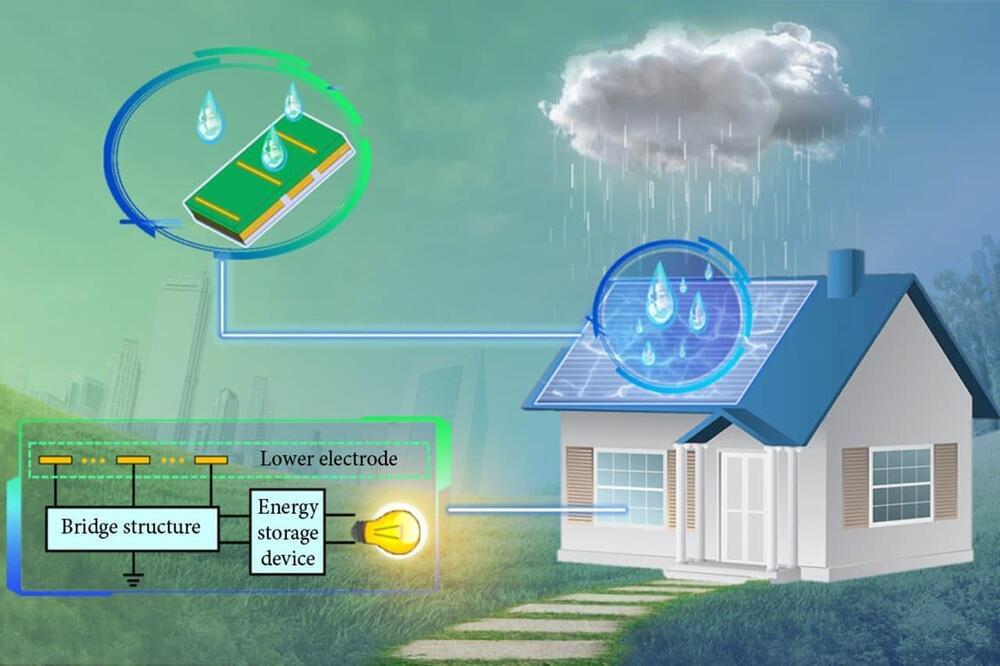Paving a potential industrial approach for effectively harvesting raindrop energy at a large scale.


Paving a potential industrial approach for effectively harvesting raindrop energy at a large scale.
I hope this isn’t been posted before especially by me. I do have a bit of pre dementia but it’s not too bad. It’s from my TBI but they’re working on weeding out bias from AI and making it so it’s not bad for us or to us.
Thought-provoking TED Talk on how AI can unintentionally reinforce societal prejudices, perpetuate discrimination, and amplify toxic behaviors online. This talk is a call to action for individuals, tech companies, and policymakers alike. By addressing AI bias and toxicity head-on, we can pave the way for a future where AI systems are truly unbiased, fostering inclusivity and equality for all.
AI, Algorithm, Behavioral Economics, Discrimination, Diversity, Empathy, Engineering, Entrepreneurship, Social Entrepreneurship, Social Media, Software, Voice, Vulnerability, Women, Women in business, Women’s Rights, Work, Workplace, Writing Product leader with over 9+ years of experience in building large scale consumer Products at Yahoo, Apple. Priya is passionate about driving innovation while building dynamic & inclusive teams. During her time at MIT, she built inclusively and won prestigious funding through MIT 100K award (previous finalists include Hubspot, Akamai). She was also invited at TedX Boston and MIT Media Lab to share her work This talk was given at a TEDx event using the TED conference format but independently organized by a local community.

Safety first. I’ve read about tech saving lives and this is a step forward along with crash detection and AFib detection and more. Our phones are legit becoming rescue and medical devices. Any experience or thoughts?
The extent of satellite support is still not evident when it comes to smartphones, but I am really looking forward to seeing how Android 14 uses this feature. It is also important to understand that all Android phones are built differently, especially when it comes to manufacturers, and while Samsung might be the biggest, with the most amount of influence, it is possible that other companies won’t introduce the feature despite the latest version of Android supporting the feature.
Whatever the case might be, Android 14 is not far away, as the update will make its debut in October alongside Pixel 8 series. You can expect the Tensor G3 to have this support. In addition to that, new flagship phones are going to start popping up, which means that we will see some compelling hardware from a variety of companies and will perhaps also get a look at which phone does support satellite SMS and other satellite-based communication features and which doesn’t.
Satellite communication on phones is still a feature that has a long way to go, and I am glad that Android 14 is bringing it to the mainstream. Here, it is important to understand that we are going to get more and more features revolving around this type of communication, and I am really hoping that more Android OEMs fall in line so we can truly have a proper, streamlined technology at our disposal.

Just as Ray Kurzweil predicted in the book The Age of Spiritual Machines.
The analysts cited Timothy Papandreou, an advisor to Alphabet’s research and development organization, X (formerly GoogleX), who explained at a recent event that A.I. will lead to a transition from a generation of programmers to a generation of “perfect prompters” as kids learn to utilize generative A.I. “assistants” throughout their lives.
Gen A won’t need programming skills to use their A.I models, instead they will work to properly prompt these systems with simple text to get the desired outcome, whether that’s finding information about Kafka for a school paper or writing an email at work.
“Children will now have an A.I. avatar shadow assistant or agent from birth. As they grow A.I. will grow with them and know everything it needs to know, and always be there as a mentor,” Papandreou said, arguing that Gen Z will be the “last generation to not grow up with AI.”

Since I was going to become a Dr before my TBI, or a scientist but there’s this and some devices and apps are pretty accurate. Like Samsung and Apple. Now there’s the Google Pixel, the Pixel watch and of course Fitbit and more.
The same devices used to take selfies and type out tweets are being repurposed and commercialized for quick access to information needed for monitoring a patient’s health. A fingertip pressed against a phone’s camera lens can measure a heart rate. The microphone, kept by the bedside, can screen for sleep apnea. Even the speaker is being tapped, to monitor breathing using sonar technology. Smartphones as medical devices could be the next big thing.
In the best of this new world, the data is conveyed remotely to a medical professional for the convenience and comfort of the patient. Or, in some cases, to support a clinician without the need for costly hardware.
But using smartphones as diagnostic tools is a work in progress, experts say. Some doctors and their patients have found some real-world success in deploying the phone as a medical device. However, the overall potential remains unfulfilled and uncertain.

Secondly, remember that all cloud services are not created equal. So, take time to select a vendor that aligns with your firm’s security, scalability and regulatory compliance requirements. Implement robust security measures at your end and prepare a plan for data backups and disaster recovery.
Lastly, remember that change management is essential. Keep the lines of communication open, address concerns proactively and involve your team throughout the transition process. Navigating these challenges can set you on the path to successful digital transformation.
Are you all set to bid farewell to those paper mountains and extend a warm welcome to the digital cloud? Cloud storage equips your law firm not only to brace for the future but to lead the vanguard in this digital revolution. Bear in mind, the future isn’t a distant entity floating far beyond our reach; it’s here. So, what’s your next strategic move in this exciting game of legal digital transformation?
Is Program Manager, Advanced Research Projects Agency for Health (ARPA-H — https://arpa-h.gov/people/ross-uhrich/), which is focused on advancing high-potential, high-impact biomedical and health research that cannot be readily accomplished through traditional research or commercial activity, accelerating better health outcomes targeting society’s most challenging health problems.
Under the ARPA-H portfolio, Dr. Uhrich is responsible for the recently launched Novel Innovations for Tissue Regeneration in Osteoarthritis (NITRO — https://arpa-h.gov/engage/programs/nitro/) program which seeks to develop new ways of helping the human body repair its own joints, with the goal of revolutionizing treatment for osteoarthritis — a common and often very painful condition where bones and cartilage break down.
Dr. Uhrich joined ARPA-H in March 2023 from Walter Reed National Military Medical Center (WRNMMC) and the Uniformed Services University of the Health Sciences, where he worked as a board-certified oral and maxillofacial surgeon and assistant professor of surgery. In addition to these roles, he spent 12 years with the U.S. Navy, finishing his tenure as a Lieutenant Commander.
Throughout his career, Dr. Uhrich has cared for thousands of members of the U.S. Armed Forces at various healthcare facilities, including the USS Gerald R. Ford, Naval Health Clinic Quantico, and WRNMMC, and served as an oral and maxillofacial surgery consultant to Congress. He also treated patients at Charleston Area Medical Center, R Adams Cowley Shock Trauma Center, and Suburban Hospital.
Dr. Uhrich holds a doctorate in dental medicine from the University of Pennsylvania, an MBA from the University of Virginia, and completed his surgical residency at WRNMMC. He also has a Bachelor of Science in Biomedical Engineering from Yale University.
Now that’s something mach can use.
MIT researchers have recently developed a portable desalination unit that can remove particles and salts to turn seawater into drinking water.
The suitcase-sized device, weighing less than ten kilograms, requires less power to operate than a cell phone charger and can also be driven by a small, portable solar panel.
It automatically generates drinking water that exceeds World Health Organization quality standards. The technology is packaged into a user-friendly device that runs with the push of a button.

Microsoft will expand access to important security log data after being criticized for locking detailed audit logs behind a Microsoft 365 enterprise plan that costs $57 per user per month. The logging updates will start rolling out “in September 2023 to all government and commercial customers,” the company said.
“Over the coming months, we will include access to wider cloud security logs for our worldwide customers at no additional cost. As these changes take effect, customers can use Microsoft Purview Audit to centrally visualize more types of cloud log data generated across their enterprise,” Microsoft announced yesterday.
Microsoft Purview Audit Premium is available on the $57-per-user Microsoft 365 E5 plan for businesses as well as the similar A5 education plan and G5 government plan. There’s also a Purview Audit Standard service that comes with a much wider range of plans, including the Microsoft 365 Business Basic tier that costs $6 per user per month.

Artificial intelligence today is spreading like wildfire. New and more powerful applications are emerging almost daily, and people are interacting with AI more in their everyday lives.
All of this is very exciting for modern enterprises, which have reinvented themselves as digital powerhouses post-pandemic. Still, digital transformations don’t happen overnight, and tech companies—and SaaS models in particular—were the saving grace of businesses sprinting to align their customer experiences with new consumer expectations and data-driven capabilities.
But AI is a different animal. Not only does it require huge sums of data, but it also requires a new approach to how that data is obtained and managed within the enterprise. Businesses expecting a simple “build it and leave it” experience with AI are in for a shock, and many will undoubtedly ask, “Can SaaS deliver AI at speed and scale?”